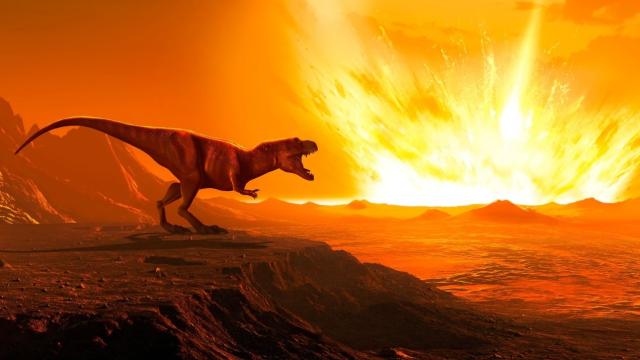A new study claims to have found the likely origin of the asteroid that wiped out the dinosaurs.
According to the Southwest Research Institute in Texas, per Space.com, the floating rock that led to the extinction of the dinosaurs came from the outer half of our solar system’s main asteroid belt, in between Mars and Jupiter.
The Chicxulub impactor is estimated to have been 9.6km wide and created a crater in Mexico’s Yucatan peninsula as large as 145km. The impact of its collision wiped out the dinosaurs and Mesozoic era, as well as 75 per cent of our planet’s fauna. Oof.
The dinosaur-killing asteroid was reportedly orbiting the sun around Mars and Jupiter before the thermal forces around it pulled it out of orbit and in the direction of our planet — the researchers call this process “escape hatching”. It’s worth noting that there’s a pretty big distance in between Mars and Jupiter and that our asteroid belt is in the space in between them.
[related_content first=”1686662″]
To come to this conclusion, researchers at SRI observed 130,000 computer models of asteroids to learn how they are pulled from their orbit in our solar system’s asteroid belt and pulled towards planets. In said study, they found that objects were ten times more likely to reach Earth from the outer asteroid belt than previously believed. Cool, cool, cool.
Interestingly, while there are a number of asteroids that orbit the Earth and that are made of similar materials to the Chicxulub impactor, they aren’t nearly as dangerous or large. To find out why that is, SRI researchers used NASA’s Pleiades Supercomputer.
It’s one of the most powerful supercomputers in the world, made up of 241,324 CPU cores and a total memory of 927tb. In 2017, the machine created a simulation of an asteroid hitting our atmosphere at 72,420kms per hour. So yeah, it’s pretty powerful.
“To explain the absence [of larger asteroids], several past groups have simulated large asteroid and comet breakups in the inner solar system, looking at surges of impacts on Earth with the largest one producing Chicxulub crater,” a researcher from the study, Dr. William Bottke, said, per Space.
“While many of these models had interesting properties, none provided a satisfying match to what we know about asteroids and comets. It seemed like we were still missing something important.”
The SRI study comes after scientists earlier this year discovered that meteorites that formed in the earliest days of the solar system may contain water, suggesting that water and life itself first arrived on Earth from the big space rocks.
